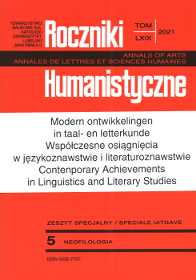Too Little Attention to Culture in Dutch and Flemish Textbooks to Learn Dutch as a Foreign Language
Abstract
It is generally acknowledged that culture and intercultural competence should be an inherent part of the foreign language teaching process. There is, however, no consensus as to the form and extent to which they should be incorporated not only into curricula but also coursebooks. By using Hofstede’s “Onion Diagram”, this paper looks at four coursebooks for Dutch as a foreign language and zooms in on the topic of “eating and drinking” to determine their (inter)cultural content. The results show that the focus in these coursebooks is on the symbols, i.e. the outer layer of the diagram. The authors of the paper offer explanations, some critical remarks and pedagogical implications, and call for a comparative approach to teaching culture and intercultural competence.
References
Boeken, Christine, Els Le Page, Els Mertens en Ingrid Peeters. Zo gezegd 1.1. Pelckmans, 2015.
Byram, Michael. Teaching and assessing intercultural communicative competence. Multilingual Matters, 1997.
Byram, Michael, Bella Gribkova en Hugh Starkey. Developing the intercultural dimension in language teaching. Council of Europe, 2001.
Claes, Marie-Thérèse en Marinel Gerritsen. Culturele waarden en communicatie ininternationaal perspectief. Coutinho, 2007.
De Leeuw, Elisabeth, Petra Roël en Annemarie Cornax. Contact! 1 Nederlands voor anderstaligen. Intertaal, 2011.
ERK. Gemeenschappelijk Europees referentiekader voor moderne vreemde talen: leren, onderwijzen, beoordelen. Nederlandse Taalunie, 2008.
Hall, Edward. Beyond culture. Anchor Book, 1976.
Hall, Edward. The hidden dimension. Doubleday, 1982.
Hofstede, Geert. Allemaal andersdenkenden. Omgaan met cultuurverschillen. Contact, 1991.
Jewdokimow, Dorota. “Minione w obecnym. O badaniu kultury jako badaniu historycznym w ujęciu semiotycznym.” Studia Kulturoznawcze, vol. 1, nr. 11, 2017, pp. 43-53.
Katan, David. Translating cultures: an introduction for translators, interpreters and mediators. Routledge, 2014.
Kramsch, Claire. Context and culture in language teaching. Oxford University Press, 1993.
Kwakernaak, Erik. “Cultuur in het vreemdetalenonderwijs: franje of kern? Deel 1: terugblik op vijf eeuwen.” Levende Talen Magazine, vol. 104, nr. 7, 2017, pp. 10-14.
Maijala, Minna. “Culture teaching methods in foreign language education: pre-service teachers’ reported beliefs and practices.” Innovation in Language Learning and Teaching, vol. 14, nr. 2, 2018, pp. 133-149.
Meyer, Meinert. “Developing transcultural competence: case studies of advanced foreign language learners.” Mediating languages and cultures, onder redactie van Dieter Buttjes en Michael Byram, Multilinguals Matters, 1990, pp. 136-158.
Piątkowska, Katarzyna. “From cultural knowledge to intercultural communicative competence: changing perspectives on the role of culture in foreign language teaching.” Intercultural Education, vol. 26, nr. 5, 2015, pp. 397-408.
Quist, Gerdi. “Taal, cultuur en interculturele communicatie: tekst als cultuurtekst in de Nvt-klas.” Neerlandistiek in Contrast. Bijdragen aan het Zestiende Colloquium Neerlandicum, onder redactie van Jane Fenoulhet, Arie J. Gelderblom, Marja Kristel, Josien Lalleman, Lut Missine en Jan Pekelder, Rozenberg Publishers, 2007, pp. 395-408.
Schneider-Broekmans, Josina. Taal vitaal – nieuw. Intertaal, 2014.
Schoenaerts, Peter, Rita Devos, Hans Fraeters en Helga van Loo. Vanzelfsprekend. Acco, 2018.
Sercu, Lies. “Teaching foreign languages in an intercultural world.” Foreign language teachers and intercultural competence. An international investigation, onder redactie van Lies Sercu, Ewa Bandura, Paloma Castro, Leah Davcheva, Chryssa Laskaridou, Ulla Lundgren, Maria del Carmen Mendez García en Phyllis Ryan, Multilingual Matters, 2005, pp. 1-18.
Copyright (c) 2021 Roczniki Humanistyczne

This work is licensed under a Creative Commons Attribution-NonCommercial-NoDerivatives 4.0 International License.





